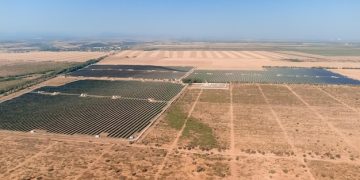US Renewable Energy: 2025 Tax Credits & Rebates Guide

The U.S. government is rolling out significant new initiatives in 2025, including expanded tax credits and rebates, to accelerate the adoption of renewable energy technologies for both homeowners and businesses, aiming to foster a sustainable future and reduce carbon emissions.
The push for a greener future is more urgent than ever, and the United States government is responding with substantial financial incentives. If you’ve been considering a transition to clean energy, understanding the New Government Initiatives for Renewable Energy: Tax Credits and Rebates in 2025 is crucial. These programs are designed to make renewable energy solutions more accessible and affordable, benefiting individual households and major industries alike.
Decoding the Renewable Energy Landscape in 2025
The year 2025 marks a pivotal moment in the U.S. renewable energy policy landscape. With increasing concerns over climate change and energy independence, the federal government, alongside state and local entities, has refined and expanded various programs. These initiatives are not merely about environmental stewardship; they also aim to stimulate economic growth, create jobs, and enhance national energy security. Understanding the nuances of these changes is key for anyone looking to invest in renewable energy.
The shift towards renewables is multifaceted, encompassing not just solar and wind power, but also geothermal, hydropower, and emerging technologies like advanced battery storage. The government’s strategy for 2025 is to provide a robust framework that supports research and development, facilitates infrastructure upgrades, and directly incentivizes adoption at various scales.
The Shift Towards Decentralized Energy
One notable trend is the increasing emphasis on decentralized energy systems. This means empowering individual homeowners, businesses, and communities to generate their own power, reducing reliance on traditional centralized grids. This approach not only enhances resilience against power outages but also fosters greater energy independence. Federal tax credits are often intertwined with state-specific programs, creating layered incentives that can significantly reduce upfront costs.
- Exploring the updated Investment Tax Credit (ITC) for residential and commercial solar installations.
- Understanding the new provisions for residential battery storage systems.
- Identifying specific state-level rebates that can be stacked with federal incentives.
For instance, while the federal ITC offers a percentage-based credit on the cost of a solar PV system, many states offer their own additional tax credits, property tax exemptions, or even direct cash rebates. Navigating this landscape requires diligence, but the potential savings can be substantial.
Another area of significant focus is the development of a skilled workforce capable of installing and maintaining these new energy systems. Government grants and educational programs are being channeled to community colleges and trade schools to train the next generation of renewable energy professionals, ensuring that the necessary human capital exists to support this transition.
In essence, 2025 is poised to be a year of accelerated growth in the renewable energy sector, propelled by comprehensive government support. These initiatives represent a long-term commitment to sustainability, offering tangible benefits for those willing to embrace cleaner energy solutions.

Key Federal Tax Credits for Renewable Energy in 2025
Among the multitude of government initiatives, federal tax credits stand out as the cornerstone of financial incentives for renewable energy adoption. These credits directly reduce the amount of income tax you owe, dollar for dollar, making them incredibly valuable. In 2025, several key tax credits are either extended, expanded, or refined, offering significant opportunities for homeowners and businesses alike.
The primary federal incentive remains the Investment Tax Credit (ITC), often referred to as the Solar Tax Credit. While historically focused on solar photovoltaic systems, its scope has broadened to include other renewable energy technologies. For residential installations, the ITC covers a significant percentage of the cost of eligible systems placed in service. This credit is not a deduction; it is a direct reduction of your tax liability.
Residential Clean Energy Credit (IRC Section 25D) Expansion
Formerly known simply as the Residential Renewable Energy Tax Credit, this enhanced provision under Internal Revenue Code Section 25D is crucial for homeowners. It allows for a non-refundable tax credit for qualified expenditures for a dwelling unit located in the United States. The credit percentage is substantial, making clean energy upgrades more accessible than ever.
- Solar Electric Property: This includes solar panels installed on your home to generate electricity.
- Solar Water Heating Property: Systems that use solar energy to heat water for residential use.
- Small Wind Energy Property: Wind turbines for residential use that generate electricity.
- Geothermal Heat Pump Property: Systems that utilize the earth’s stable underground temperatures to heat and cool homes.
- Battery Storage Technology: For systems installed starting in 2023, battery storage can also qualify if it has a capacity of at least 3 kilowatt-hours (kWh). This is a game-changer for energy independence and resilience.
It’s important to note that the equipment must be new and placed in service within the tax year. There are generally no maximum credit amounts for most residential systems, making it a very attractive incentive. However, specific eligibility criteria and phase-out schedules (if any) should always be verified with the latest IRS guidelines or a tax professional.
Beyond the direct tax credit, these installations can also increase your property value without necessarily increasing your property taxes, thanks to specific state exemptions. This dual benefit of reduced utility bills and enhanced home value makes renewable energy investments increasingly compelling.
For businesses, the Commercial Clean Energy Credit (part of the larger ITC framework) also provides substantial incentives for large-scale renewable energy projects. These often come with additional requirements, such as prevailing wage and apprenticeship provisions, designed to ensure high-quality job creation and fair labor practices within the green energy sector. These requirements underline the government’s commitment not only to clean energy but also to equitable economic development.
Understanding Rebates: Instant Savings and Local Programs
While federal tax credits offer significant savings at tax time, rebates provide a more immediate financial benefit, often reducing the upfront cost of renewable energy installations directly at the point of sale or shortly thereafter. These programs are typically administered by state governments, local municipalities, or utility companies, and they can vary significantly depending on your location.
Rebates are essentially discounts or refunds provided for purchasing or installing specific energy-efficient or renewable energy products. Unlike tax credits, which reduce your tax liability, rebates are a type of direct financial incentive that usually don’t require you to wait until you file your taxes to realize the savings. This immediate impact can make renewable energy systems much more accessible for many households and businesses.
State-Specific Renewable Energy Rebates
Many U.S. states have robust rebate programs designed to complement federal incentives. These can range from flat-rate amounts per installation to per-watt incentives for solar panels. Some states also offer rebates for energy-efficient appliances, electric vehicle charging infrastructure, or upgrades to home insulation, all contributing to a broader energy independence goal.
- Examples include state rebates for purchasing solar water heaters or geothermal systems.
- Identification of utility company cash-back programs for energy-efficient upgrades.
- Understanding the process for applying for local municipality grants or loans for renewable projects.
For instance, states with ambitious renewable portfolio standards (RPS) often provide more aggressive rebate structures to encourage widespread adoption. Researching your specific state’s energy office website or contacting your local utility company is usually the first step in uncovering these opportunities. Programs can change annually, so it’s essential to check for the most current information for 2025.
Some utility companies, in a bid to manage peak demand and promote energy conservation, offer their own rebate programs. These might be for smart thermostats, efficient HVAC systems, or even incentives for homeowners who allow the utility to manage their battery storage systems during high-demand periods. These “demand-response” programs can be particularly beneficial, offering both a rebate and ongoing savings.
It’s also worth investigating any local city or county programs. Some urban areas or counties have their own sustainability initiatives, often funded through local taxes or grants, that provide additional incentives for residents or businesses to install renewable energy systems. These local programs can sometimes be the differentiator, making a project financially viable when combined with federal and state aid.
While rebates offer instant gratification, it’s crucial to carefully review their terms and conditions. Some may have caps, income eligibility requirements, or specific product criteria. Always ensure that the contractors and equipment you choose qualify for the available rebates to avoid any unexpected financial surprises.
Expanded Eligibility and New Opportunities in 2025
The landscape of renewable energy incentives is not static; it evolves to address new market needs, technological advancements, and policy priorities. In 2025, we are seeing notable expansions in eligibility criteria and the emergence of fresh opportunities, making a broader range of projects and individuals viable candidates for financial support. This expansion reflects a commitment to making clean energy transition inclusive and far-reaching.
One significant area of expansion relates to the types of technologies that qualify for incentives. Beyond the traditional solar and wind, there’s increased support for less common but equally impactful renewable energy sources and complementary technologies. This includes a strengthened focus on energy storage solutions and grid modernization, which are critical for the reliability of a renewable-heavy energy system.
Inclusivity and Community Solar Initiatives
A key focus for 2025 is enhancing access to renewable energy for low-income communities and renters, who have historically faced barriers to adoption. New provisions aim to address these disparities, including specific bonus credits or grants for projects located in disadvantaged communities or those that directly benefit low-income households. This aligns with broader environmental justice goals.
- Programs supporting community solar projects, which allow multiple subscribers to benefit from a single, large off-site solar installation.
- Bonus credits for projects that meet domestic content requirements, encouraging U.S. manufacturing of renewable energy components.
- Incentives for projects built in “energy communities” – areas historically reliant on fossil fuel industries – aiding their economic transition.
Community solar is gaining significant traction, enabling individuals who cannot install solar panels on their own property (due to shading, roof structural issues, or rental agreements) to still participate in and benefit from solar energy. These projects often come with dedicated state or utility-level support, sometimes even offering guaranteed bill credits.
Furthermore, there’s a growing emphasis on “energy communities,” defined as areas with a significant reliance on fossil fuel production or employment. Projects developed in these regions may qualify for additional tax credits, aiming to provide economic transition opportunities and job creation in areas historically dependent on coal, oil, or gas industries. This dual approach tackles both environmental and economic challenges synergistically.
Another emerging area of opportunity lies in the development of manufacturing capabilities for renewable energy components within the United States. Federal initiatives are providing significant incentives, including production tax credits, for companies that produce solar panels, wind turbine components, and battery cells domestically. This not only strengthens the supply chain but also creates high-paying manufacturing jobs across the country.
These expanded eligibilities and new opportunities signal a comprehensive approach to renewable energy development. By broadening the scope of what qualifies and who can benefit, the government aims to accelerate the transition to a clean energy economy while ensuring that the benefits are widely distributed across all segments of the population and diverse geographic regions.

Navigating Application Processes for 2025 Incentives
While the availability of robust tax credits and rebates is exciting, successfully claiming these benefits requires a clear understanding of the respective application processes. Each incentive program, whether federal, state, or local, will have its own specific set of requirements, documentation needs, and submission deadlines. Diligence and attention to detail are paramount to ensure you receive your deserved financial support.
For federal tax credits, the process typically involves claiming the credit when you file your annual income tax return. This usually means filling out specific IRS forms, such as Form 5695 for residential energy credits, and attaching them to your Form 1040. Keeping meticulous records of your eligible expenses, including invoices and proof of installation, is crucial for substantiating your claim.
Tips for a Smooth Application
The complexity often lies in harmonizing federal requirements with varying state and local rules. Some state rebate programs operate on a first-come, first-served basis due to limited funding, making timely application critical. Others might require pre-approval before installation begins. Understanding these nuances can prevent delays or disqualification.
- Maintaining comprehensive records of all purchases, installations, and contractor agreements.
- Consulting with a qualified tax professional or energy expert to understand specific eligibility.
- Diligently checking official government and utility websites for the latest program updates.
For state and local rebates, the process often involves submitting an application form online or by mail, along with proof of purchase, installation, and sometimes energy performance certificates. Many programs require that the equipment be installed by a certified contractor and that it meets specific efficiency standards. It’s wise to confirm these details before committing to a purchase.
Utility company rebates are often simpler, sometimes requiring just an online form submission with a copy of your utility bill and the product invoice. However, even these can have specific windows for application or limitations on the types of products that qualify. Always check if the rebate is processed by the utility directly or through a third-party administrator.
It’s also important to be aware of any “stacking” rules. Some programs allow you to combine multiple incentives (e.g., a federal tax credit, a state rebate, and a utility incentive), while others may have limits on the total amount of financial assistance you can receive. Professional installers and energy auditors are often knowledgeable about these rules and can offer valuable guidance.
Before any major investment, spend time researching the specific incentives available for your location and the type of renewable energy system you are considering. Many state energy offices offer online databases or resource guides that consolidate information on various programs. Being well-informed is the best way to maximize your benefits and ensure a smooth application process for 2025 initiatives.
Beyond Tax Credits and Rebates: Other Government Support
While tax credits and rebates are the most direct and widely recognized financial incentives for renewable energy, the U.S. government’s commitment extends far beyond these. A broader ecosystem of support mechanisms aims to foster innovation, strengthen infrastructure, and facilitate the long-term growth of the clean energy sector. Understanding these additional programs provides a more complete picture of the landscape of opportunities.
These additional forms of support include grants, loan programs, research and development funding, and regulatory frameworks designed to promote grid modernization and renewable energy integration. They often target different stages of renewable energy project development or specific segments of the economy, from large-scale utility projects to small rural development initiatives.
Grants and Loan Programs for Businesses and Communities
For businesses, non-profits, and governmental entities, various federal agencies offer grants and low-interest loan programs. These are often competitive and target projects with significant public benefit, such as community-scale renewable energy installations, energy efficiency upgrades for public buildings, or the development of innovative clean energy technologies.
- USDA Rural Energy for America Program (REAP) grants and loan guarantees for rural small businesses and agricultural producers.
- Department of Energy (DOE) grants for cutting-edge research and deployment of advanced energy technologies.
- HUD programs that support energy-efficient upgrades in affordable housing developments.
The U.S. Department of Agriculture (USDA), for example, administers the Rural Energy for America Program (REAP), which provides grants and loan guarantees to rural small businesses and agricultural producers to purchase, install, and construct renewable energy systems or make energy efficiency improvements. This program is critical for empowering rural economies to adopt sustainable practices.
The Department of Energy (DOE) frequently issues solicitations for grants supporting research, development, and demonstration (RD&D) of next-generation renewable energy technologies. These grants are vital for bringing new innovations from the lab to commercial viability, encompassing areas like advanced geothermal systems, offshore wind technology, and novel battery chemistries.
Furthermore, federal loan programs, often administered through entities like the Small Business Administration (SBA) or the Department of Energy’s Loan Programs Office, provide access to capital for larger clean energy projects that might struggle to secure traditional financing. These loans often come with favorable terms, making them attractive for significant investments in renewable infrastructure.
Beyond direct financial aid, the government also plays a crucial role in establishing policies that encourage renewable energy. This includes setting renewable energy standards for utilities, streamlining permitting processes for renewable energy projects, and investing in grid infrastructure upgrades to accommodate more intermittent renewable sources. These regulatory and infrastructural supports are as important as financial incentives in driving the widespread adoption of clean energy.
In essence, the federal government’s approach to renewable energy is comprehensive, utilizing a mix of financial incentives, research funding, and strategic policy frameworks. This multi-pronged strategy aims to accelerate the transition to a sustainable energy future, benefiting both the environment and the economy.
The Long-Term Impact: Sustainability and Economic Growth
The current wave of government initiatives for renewable energy, including the expanded tax credits and rebates in 2025, is not just about short-term financial relief; it represents a strategic investment in the nation’s long-term sustainability and economic growth. The widespread adoption of clean energy technologies promises profound and lasting impacts on various facets of American life, extending well beyond individual upfront savings.
One of the most immediate and critical impacts is the reduction of greenhouse gas emissions. Transitioning from fossil fuels to renewable sources significantly lowers the carbon footprint of the energy sector, contributing directly to climate change mitigation. This environmental benefit, while sometimes intangible to the individual consumer, is a cornerstone of national and global climate goals.
Job Creation and Energy Independence
Economically, the renewable energy sector is a significant engine of job creation. Investments in solar, wind, geothermal, and other clean technologies lead to demand for installers, manufacturers, engineers, maintenance technicians, and researchers. These are often well-paying jobs that cannot be easily offshored, fostering local economic development and strengthening the national workforce.
- Growth of green jobs across various sectors, from manufacturing to installation and maintenance.
- Enhanced national energy security through reduced reliance on volatile global fuel markets.
- Stimulation of technological innovation and market competitiveness within the U.S.
Furthermore, increased reliance on domestic renewable energy sources enhances national energy independence. By reducing dependence on imported fossil fuels, the U.S. becomes less vulnerable to geopolitical instability and price fluctuations in global energy markets. This strengthens economic resilience and provides greater price stability for consumers.
The push for renewable energy also spurs significant technological innovation. As the demand for cleaner and more efficient systems grows, so does research and development into new materials, improved system designs, and advanced energy storage solutions. This innovation not only makes renewable energy more efficient and cost-effective but also positions the U.S. as a leader in global clean energy technologies, creating export opportunities and maintaining a competitive edge.
Beyond job creation, the investment in local renewable energy projects circulates money within communities. Residential and commercial installations support local businesses and contractors, and the savings on energy bills can be reinvested in local economies. This localized economic benefit is often overlooked but is a crucial aspect of the positive ripple effect.
Finally, there’s the long-term benefit of improved public health. Reduced air pollution from burning fossil fuels leads to fewer respiratory illnesses and other health issues, resulting in lower healthcare costs and a better quality of life for communities. These societal benefits, though perhaps harder to quantify, are a powerful reason behind the government’s continued support for renewable energy.
In summary, the government initiatives in 2025 are planting seeds for a more sustainable and prosperous future. The impact of these policies will resonate for decades, shaping an economy that is cleaner, more resilient, and built on the foundation of renewable energy.
| Key Point | Brief Description |
|---|---|
| ☀️ Federal Tax Credits | Significant non-refundable credits for solar, wind, geothermal, and battery storage. |
| 💰 State & Local Rebates | Immediate financial incentives reducing upfront costs, varying by location. |
| ⚡ Expanded Eligibility | New opportunities for battery storage, community solar, and low-income areas. |
| 🌱 Long-Term Impact | Aids environmental sustainability, job creation, and energy independence. |
Frequently Asked Questions About 2025 Renewable Energy Incentives
The Residential Clean Energy Credit (IRC Section 25D) is a federal tax credit for homeowners installing eligible renewable energy equipment. In 2025, it applies to solar, wind, geothermal, and qualified battery storage systems. It’s a non-refundable credit, meaning it reduces your tax liability directly, and there are generally no maximum credit amounts for most systems, making it highly beneficial for clean energy upgrades.
Yes, starting in 2023, battery storage technology is eligible for the Residential Clean Energy Credit if it has a capacity of at least 3 kilowatt-hours (kWh). This eligibility continues into 2025, significantly incentivizing homeowners to install systems that enhance energy resilience and allow for greater utilization of self-generated renewable power. This is a key development for home energy independence.
Federal tax credits reduce your income tax liability, offering savings when you file taxes. State and local rebates, conversely, provide more immediate financial benefits, often as upfront discounts or direct refunds. They vary by location and are usually managed by state energy offices, municipalities, or utility companies, providing supplementary savings to federal incentives. These can reduce the initial cost significantly.
Yes, 2025 initiatives include provisions for bonus credits or grants for renewable energy projects located in disadvantaged communities or “energy communities” (areas historically reliant on fossil fuel industries). These measures aim to promote equitable access to clean energy benefits, support economic transition in vulnerable regions, and ensure the benefits of renewable energy are widely distributed among all populations.
The initiatives primarily cover solar electric (PV) and solar water heating, small wind turbines, geothermal heat pumps, and qualified battery storage. Eligibility is expanding to include more technologies and projects that contribute to grid modernization and energy independence. Always confirm specific eligibility criteria with published government guidelines or a tax professional for the latest details on qualifying systems for 2025.
Conclusion
The journey towards a sustainable future is a collective endeavor, and the U.S. government’s bold initiatives in 2025 underscore its unwavering commitment. The enhanced array of tax credits, significant rebates, and expanded eligibility criteria for renewable energy technologies present an unprecedented opportunity for individuals, businesses, and communities to embrace cleaner energy solutions. These programs not only ease the financial burden of transitioning to renewables but also catalyze economic growth, foster job creation, and bolster national energy security. By understanding and leveraging these robust incentives, we can collectively accelerate the shift towards a greener, more resilient, and environmentally responsible energy landscape for generations to come. Staying informed and actively participating in these programs is key to unlocking the full potential of renewable energy in the United States.





